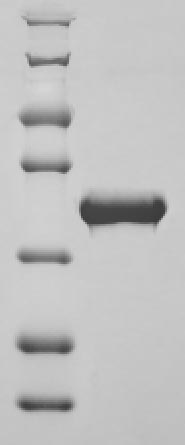Bovine ApoAI Recombinant Protein Product Attributes
Product Type: Recombinant Protein
Recombinant ApoAI based upon sequence from: Bovine
Host: QP8986 protein expressed in Yeast.
Tag: His
Protein Construction: A DNA sequence encoding the Bos taurus (Bovine) ApoAI, was expressed in the hosts and tags indicated. Please select your host/tag option, above.
Application Notes: Please contact us for application specific information for QP8986.
Bioactivity Data: Untested
Full Length? Full Length
Expression Region: Asp25 – Gln265
Amino Acid Sequence: DDPQSSWDRV KDFATVYVEA IKDSGRDYVA QFEASALGKQ LNLKLLDNWD TLASTLSKVR EQLGPVTQEF WDNLEKETAS LRQEMHKDLE EVKQKVQPYL DEFQKKWHEE VEIYRQKVAP LGEEFREGAR QKVQELQDKL SPLAQELRDR ARAHVETLRQ QLAPYSDDLR QRLTARLEAL KEGGGSLAEY HAKASEQLKA LGEKAKPVLE DLRQGLLPVL ESLKVSILAA IDEASKKLNA Q
Purity: Greater than 90% as determined by SDS-PAGE.
Reconstitution Instructions:
Concentration of Bovine ApoAI Protein:
Endotoxin Levels: Not determined.
Buffer: Tris-based buffer, 50% glycerol
Storage Conditions: Store at -20C to -80C.
| Recombinant Bovine ApoAI Protein General Information | |
|---|---|
| Alternate Names | |
| ApoAI; apo-AI; Sep2; Ltw-1; Apoa-1; Brp-14; apoA-I; Alp-1; Sep-2; Lvtw-1; Sep-1 | |
| Curated Database and Bioinformatic Data | |
| Gene Symbol | APOA1 |
| Entrez Gene ID | 281631 |
| Ensemble Gene ID | ENSBTAG00000002258 |
| RefSeq Protein Accession(s) | NP_776667.2 |
| RefSeq mRNA Accession(s) | NM_174242.3 |
| UniProt ID(s) | P15497 |
| UniGene ID(s) | Bt.49157 |
| COSMIC ID Link(s) | APOA1 |
| KEGG Gene ID(s) | bta:281631 |
| General Description of Recombinant Bovine ApoAI Protein. | |
| Participates in the reverse transport of cholesterol from tissues to the liver for excretion by promoting cholesterol efflux from tissues and by acting as a cofactor for the lecithin cholesterol acyltransferase (LCAT). As part of the SPAP complex, activates spermatozoa motility. | |
Limitations and Performance Guarantee
This is a life science research product (for Research Use Only). This product is guaranteed to work for a period of two years when stored at -70C or colder, and one year when aliquoted and stored at -20C.




Reviews
There are no reviews yet.